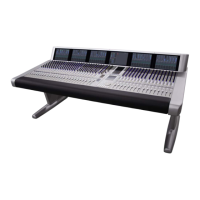
Do you have a question about the Euphonix System 5 and is the answer not in the manual?
| Brand | Euphonix |
|---|---|
| Model | System 5 |
| Category | Music Mixer |
| Language | English |
Provides guidance on navigating and utilizing the operation manual effectively.
Details the core components and architecture of the System 5 digital mixing system.
Outlines the step-by-step procedure for powering on and initializing all system components.
Introduces automated triggering of snapshots and cross-fading capabilities for scenes.
Describes user-assignable processing functions for busses, including limiter, compressor, and filters.
Highlights the new Windows Control Panel for easier sync, redundancy, and network configurations.
Guides users through connecting a CD player and routing audio for playback.
Explains how to configure and monitor microphone inputs through the system.
Covers file management operations like Projects, Titles, and Mixes within the eMix application.
Details the digital patching system for connecting sources to destinations using a MADI routing hub.
Explains the configuration and formatting of Group and Mix busses, including the Law Palette.
Discusses system customization, Mixer Models, and DSP configuration based on hardware.
Explains how to access and use the Euphonix Control Panel for sample rate, sync sources, and configuration.
Covers multi-format monitor outputs, routing, and source selection for the master section.
Details the system's communication features, including talkback, listenback, and oscillator/slate.
Explains the extensive solo control system, modes, speaker selection, and solo-safe features.
Describes how to set up and configure channel and master section meters using presets and configuration panels.
Provides easy physical access to channels and control groups for assignment to the center strip.
Explains how center section knobsets extend access to functions like dynamics, EQ, Aux, and input.
Details how to view and control Group and Mix bus routing for channels assigned to the center strip.
Introduces the four bus types: Mix, Group, Aux, and Solo, and their configurations.
Covers functions of the Bus Master strip, including Aux, Grp, Mix Masters, Bus Lock, and Mon Lock.
Explains digital processing capabilities for busses, including limiter, compressor, and filters.
Describes the physical control area of the console, including switches, knobs, displays, and faders.
Details channel naming, function keys, rotary knobs, and touch-sensitive faders for strip control.
Explains the configurable order of channel processing functions and available patch points.
Covers flexible channel functions like Input, Dynamics, EQ, Filters, Aux Sends, and Panning.
Details Group Bus Routing, Mix Bus Routing, and Mix Minus outputs for channel mixing.
Guides users on how to create parameter links to control multiple values simultaneously.
Explains procedures for altering existing links or clearing them entirely.
Describes how to control linked channels using a joystick panner for parameter adjustments.
Explains how to create and manage Control Groups for controlling multiple slave channels from a master.
Details the creation and use of Multi Format Masters for building stereo, surround, and other channel formats.
Covers the Spill function for temporarily assigning slave channels of a group to predefined strips.
Explains how to store, recall, and manage channel-to-strip mappings for console configurations.
Describes storing and recalling selected channel functions, switch states, and settings.
Covers manual or event-triggered snapshots and automated sequences with glide and delay times.
Details standard transport functions like Play, Rewind, Stop, Record, and additional shuttle/jog controls.
Explains how to precisely locate and manage cue points, registers, and time displays.
Covers system controls for track arming and record status, including motion and stop conditions.
Lists and describes various input types for event configuration, including Control Room, Fader, and GPI.
Lists and describes various output types for event configuration, including Control Room, GP Output, and Switch Output.
Guides users to the Events screen for configuring inputs, outputs, and event logic operators.
Provides practical examples of setting up GPI events, such as fader control and video switcher integration.
Explains the interface for automated parameters, including read/write LEDs and select/punch keys.
Details the different automation modes like Isolate, Read, Write Absolute, and Write Trim.
Covers methods for assigning automation modes globally or per strip/parameter.
Guides users on recording fader and knob automation, including punch-in/out methods.
Explains how controls behave during automation playback in different modes.
Describes techniques for modifying automation, including glide modes and auto take-over.
Introduces utilities like AutoFill, Fill Start, Fill End, and Fill Region for writing automation values.
Details utilities for previewing, punching, capturing, and managing automation passes.
Introduces the CM403 module for PEC/Direct monitoring in post-production environments.
Describes the Film Panel's PEC/DIR and utility sections for monitoring and setup functions.
Covers the joystick module's functions, assignment modes, and automation control.
Explains the setup and operation of multi-operator System 5 consoles.
Details machine control synchronization and operation in film environments.
Describes the system's support for track arming up to 48 tracks via MIDI or P2.
Explains the Solo-In-Place function and how it affects monitor sourcing.
